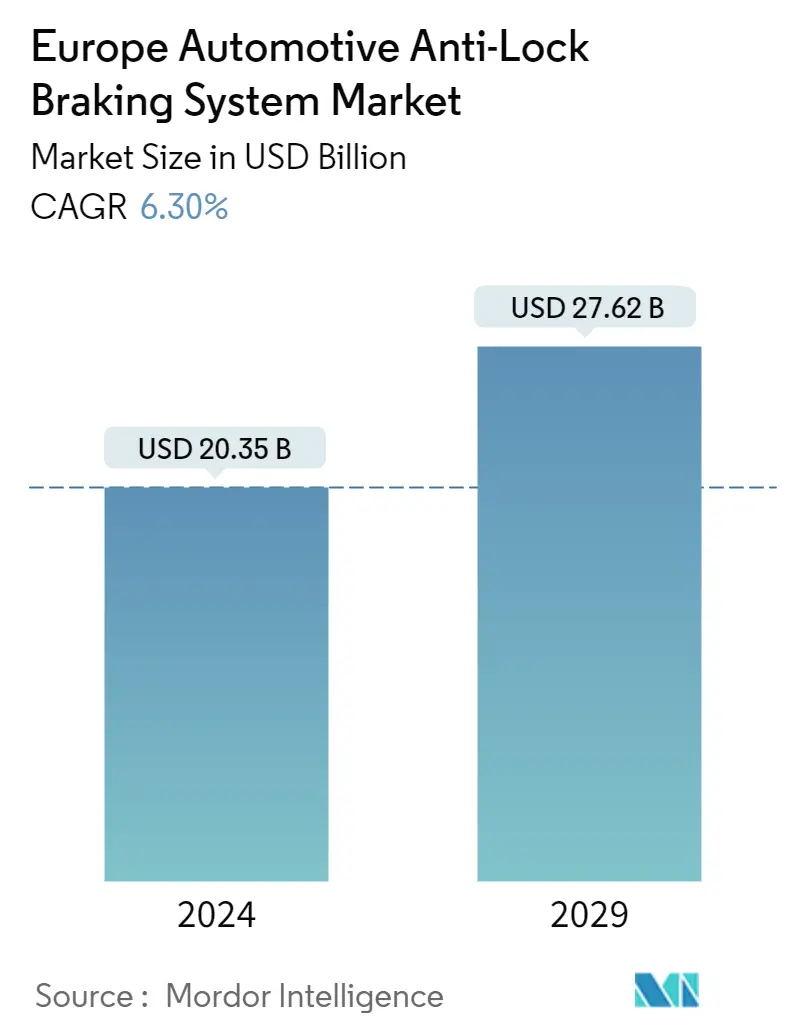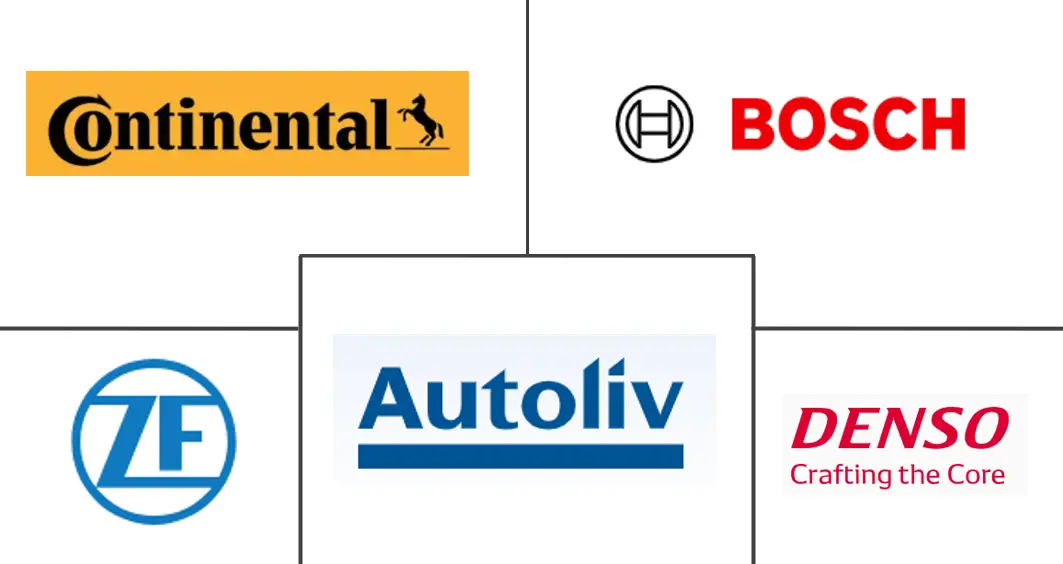Market Size of Europe Automotive Anti-Lock Braking System Industry

| Study Period | 2019 - 2029 |
| Market Size (2024) | USD 20.35 Billion |
| Market Size (2029) | USD 27.62 Billion |
| CAGR (2024 - 2029) | 6.30 % |
| Fastest Growing Market | Europe |
| Largest Market | Europe |
| Market Concentration | High |
Major Players
*Disclaimer: Major Players sorted in no particular order |
Europe Automotive Anti-Lock Braking System Market Analysis
The Europe Automotive Anti-Lock Braking System Market size is estimated at USD 20.35 billion in 2024, and is expected to reach USD 27.62 billion by 2029, growing at a CAGR of 6.30% during the forecast period (2024-2029).
- COVID-19 had a severe impact on the market due to the indirect consequence of low automotive production and sales registered in 2020 due to the pandemic. However, with the expected increase in sales of passenger vehicles and increased awareness of safety in both passenger and commercial vehicles, the market is looking forward to reviving and growing economically back to pre-covid conditions.
- Over the long term, Growing production of vehicles with integrated safety features in the wake of rising awareness toward the comfort and safety of passengers and government regulations mandating safety features are expected to drive demand in the market. Moreover, the rising acceptance of self-driving or automated vehicles further contributes to the enhanced growth of the market.
- Nowadays, an anti-lock braking system (ABS) is used in every modern car. It automatically provides optimum braking force short of lockup. The computers modulate the brake pressure to ensure that all wheels maintain traction, allowing them to brake and steer simultaneously.
- Europe is known for its swift and stringent adaption toward road safety. Countries such as Germany and the United Kingdom have mandated entry-level vehicles to install ABS systems just as important as seatbelts seen today in every car.
- However, ABS in 2-wheelers, especially in cost-conscious markets, sometimes offer options for a single channel, with only a front wheel equipped with an ABS. Additionally, entry-level cars are not provided by ABS with a higher safety system. However, with emerging technologies and growing government policies, entry-level and 2- wheelers may see higher adoption of ABS systems since results have shown that even a lower ABS-equipped system may increase braking distances.
Europe Automotive Anti-Lock Braking System Industry Segmentation
An anti-lock braking system (ABS) is a safety anti-skid braking system used on aircraft and land vehicles, such as cars, motorcycles, trucks, and buses. ABS operates by preventing the wheels from locking up during braking, thereby maintaining tractive contact with the road surface and allowing the driver to maintain more control over the vehicle.
The European automotive anti-lock braking system market is segmented by vehicle type, technology type, sales channel, and country. Based on the vehicle type, the market is segmented into motorcycles, passenger cars, and commercial vehicles. Based on the Technology type, the market is segmented into Sensors, hydraulic units, and electronic control units. Based on the Sales Channel, the market is segmented into OEM and Aftermarket. Based on the country, the market is segmented into Germany, the United Kingdom, Italy, France, and the Rest of Europe.
For each segment, the market sizing and forecast have been done based on the value (USD).
| By Vehicle Type | |
| Motorcycles | |
| Passenger Cars | |
| Commercial Vehicles |
| By Technology Type | |
| Sensors | |
| Hydraulic Unit | |
| Electronic Control Unit |
| By Sales Channel | |
| OEM | |
| Aftermarket |
| By Country | |
| Germany | |
| United Kingdom | |
| Italy | |
| France | |
| Rest of Europe |
Europe Automotive Anti-Lock Braking System Market Size Summary
The European automotive anti-lock braking system market is poised for significant growth, driven by increasing demand for vehicle safety and stringent regulatory standards. The market is recovering from the setbacks caused by the COVID-19 pandemic, which had adversely affected automotive production and sales. As awareness of safety features in both passenger and commercial vehicles rises, and with government regulations mandating these systems, the market is expected to regain its momentum. The integration of anti-lock braking systems in modern vehicles, including passenger cars and motorcycles, is becoming standard, with countries like Germany and the United Kingdom leading the charge in road safety initiatives. The adoption of self-driving and automated vehicles further propels the market, as these technologies require advanced safety features to ensure passenger safety and vehicle control.
Key players in the European market, such as Robert Bosch GmbH, Autoliv Inc., and Continental AG, are actively engaging in partnerships and product innovations to maintain a competitive edge. The market's expansion is supported by the presence of major automotive manufacturers and suppliers in Germany, which is a hub for automotive research and development. Government incentives and investments in clean vehicles also contribute to the market's growth. The European Transport Safety Council's mandates for anti-lock braking systems in all new motorcycles and calls for automated emergency braking systems in new cars underscore the region's commitment to enhancing vehicle safety. As a result, the market is expected to witness robust growth during the forecast period, with ongoing developments and technological advancements playing a crucial role.
Europe Automotive Anti-Lock Braking System Market Size - Table of Contents
-
1. MARKET DYNAMICS
-
1.1 Market Driver
-
1.1.1 Growing demand for safety Features in Vehicles
-
1.1.2 Others
-
-
1.2 Market Restraint
-
1.2.1 High cost of Maintenance
-
1.2.2 Others
-
-
1.3 Industry Attractiveness - Porter's Five Forces Analysis
-
1.3.1 Bargaining Power of Buyers/Consumers
-
1.3.2 Bargaining Power of Suppliers
-
1.3.3 Threat of New Entrants
-
1.3.4 Threat of Substitute Products
-
1.3.5 Intensity of Competitive Rivalry
-
-
-
2. MARKET SEGMENTATION (Market Size in Value - USD Billion)
-
2.1 By Vehicle Type
-
2.1.1 Motorcycles
-
2.1.2 Passenger Cars
-
2.1.3 Commercial Vehicles
-
-
2.2 By Technology Type
-
2.2.1 Sensors
-
2.2.2 Hydraulic Unit
-
2.2.3 Electronic Control Unit
-
-
2.3 By Sales Channel
-
2.3.1 OEM
-
2.3.2 Aftermarket
-
-
2.4 By Country
-
2.4.1 Germany
-
2.4.2 United Kingdom
-
2.4.3 Italy
-
2.4.4 France
-
2.4.5 Rest of Europe
-
-
Europe Automotive Anti-Lock Braking System Market Size FAQs
How big is the Europe Automotive Anti-Lock Braking System Market?
The Europe Automotive Anti-Lock Braking System Market size is expected to reach USD 20.35 billion in 2024 and grow at a CAGR of 6.30% to reach USD 27.62 billion by 2029.
What is the current Europe Automotive Anti-Lock Braking System Market size?
In 2024, the Europe Automotive Anti-Lock Braking System Market size is expected to reach USD 20.35 billion.

